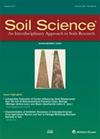Biocrust-linked changes in soil aggregate stability along a climatic gradient in the Chilean Coastal Range
4区 农林科学
Q2 Agricultural and Biological Sciences
引用次数: 4
Abstract
Abstract. Biological soil crusts (biocrusts) composed of cyanobacteria, bacteria, algae, fungi, lichens, and bryophytes stabilize the soil surface. This effect has mainly been studied in arid climates, where biocrusts constitute the main biological agent to stabilize and connect soil aggregates. Besides, biocrusts are an integral part of the soil surface under Mediterranean and humid climate conditions, mainly covering open spaces in forests and on denuded lands. They often develop after vegetation disturbances, when their ability to compete with vascular plants increases, acting as pioneer communities and affecting the stability of soil aggregates. To better understand how biocrusts mediate changes in soil aggregate stability under different climate conditions, we analyzed soil aggregate samples collected under biocrust communities from four national parks in Chile along a large climatic gradient ranging from (north to south) arid (Pan de Azúcar, PA), semi-arid (Santa Gracia, SG), Mediterranean (La Campana, LC) to humid (Nahuelbuta, NA). Biocrust communities showed a stabilizing effect on the soil aggregates in dry fractions for the three northern sites and the wet aggregates for the southernmost site. Here, permanent vascular plants and higher contents of organic carbon and nitrogen in the soil control aggregate stability more than biocrusts, which are in intense competition with higher plant communities. Moreover, we found an increase in stability for aggregate size classes < 2.0 and 9.5–30.0 mm. The geometric mean diameter of the soil aggregates showed a clear effect due to the climatic gradient, indicating that the aggregate stability presents a log-normal instead of a normal distribution, with a trend of low change between aggregate size fractions. Based on our results, we assume that biocrusts affect the soil structure in all climates. Their role in aggregate stability is masked under humid conditions by higher vegetation and organic matter contents in the topsoil.智利沿海山脉沿气候梯度与生物壳相关的土壤团聚体稳定性变化
摘要由蓝藻、细菌、藻类、真菌、地衣和苔藓植物组成的生物土壤结皮(biocrusts)稳定土壤表面。这种效应主要在干旱气候条件下进行研究,在那里生物结皮是稳定和连接土壤团聚体的主要生物制剂。此外,在地中海和湿润气候条件下,生物结皮是土壤表面的一个组成部分,主要覆盖在森林和荒地的空地上。它们通常在植被扰动后发展,与维管植物竞争的能力增强,作为先锋群落,影响土壤团聚体的稳定性。为了更好地理解生物结皮如何在不同气候条件下调节土壤团聚体稳定性的变化,我们分析了在智利四个国家公园的生物结皮群落中收集的土壤团聚体样本,这些土壤团聚体样本沿着(从北到南)干旱(Pan de Azúcar, PA),半干旱(Santa Gracia, SG),地中海(La Campana, LC)到湿润(Nahuelbuta, NA)的大气候梯度。生物结壳群落对北部3个样地的干组分土壤团聚体和最南部样地的湿组分土壤团聚体具有稳定作用。此处,永久维管植物和土壤中较高的有机碳和氮含量比生物结皮更能控制团聚体的稳定性,而生物结皮与高等植物群落之间存在激烈的竞争。此外,我们发现骨料粒径< 2.0和9.5-30.0 mm的稳定性增加。土壤团聚体几何平均直径受气候梯度的影响明显,表明团聚体稳定性呈现对数正态分布,而不是正态分布,团聚体粒径之间的变化趋势较小。根据我们的研究结果,我们假设生物结皮影响所有气候条件下的土壤结构。在潮湿条件下,它们在团聚体稳定性中的作用被表层土壤中较高的植被和有机质含量所掩盖。
本文章由计算机程序翻译,如有差异,请以英文原文为准。
求助全文
约1分钟内获得全文
求助全文
来源期刊

Soil Science
农林科学-土壤科学
CiteScore
2.70
自引率
0.00%
发文量
0
审稿时长
4.4 months
期刊介绍:
Cessation.Soil Science satisfies the professional needs of all scientists and laboratory personnel involved in soil and plant research by publishing primary research reports and critical reviews of basic and applied soil science, especially as it relates to soil and plant studies and general environmental soil science.
Each month, Soil Science presents authoritative research articles from an impressive array of discipline: soil chemistry and biochemistry, physics, fertility and nutrition, soil genesis and morphology, soil microbiology and mineralogy. Of immediate relevance to soil scientists-both industrial and academic-this unique publication also has long-range value for agronomists and environmental scientists.
 求助内容:
求助内容: 应助结果提醒方式:
应助结果提醒方式:


